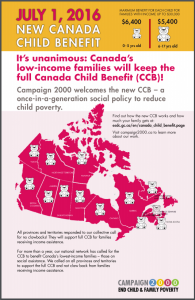The Canada Child Benefit: A national innovation to reduce child and family poverty

By Martha Friendly, Executive Director, Childcare Resource and Research Unit
Canada’s persistent child poverty
From 1981 to 1997, the national rate of children living in poverty rose from 10.3% to 18.4%.1In 2016, 18.5% of children aged 0 – 18 lived in poverty (approximately 1.3 million children).2Canada’s proportion of children living under the poverty line has not dropped below 18.5% since 2000.1
Some children are particularly likely to experience poverty. In Canada, in 2014, 24% of children in single-parent families were living in poverty, and 92% of these children lived in a family that was headed by a female parent.3 Fifty-one per cent of status First Nations children and 60% of First Nations children on reserve live in poverty.4
Multi-faceted policy proposals to combat child poverty
Anti-poverty organizations such as Campaign 2000 and Canada Without Poverty have historically taken a multi-faceted approach to alleviating poverty, including proposals for affordable housing, universal child care, good jobs, parent supports and adequate family income.5 A key component of these poverty reduction recommendations has long been a demand for a geared-to-income child benefit directed to families, robust enough to have an impact on family poverty.
In response to a 1989 unanimously supported motion in Parliament to eradicate child poverty by the year 2000, a child benefit was introduced across Canada. Although the national child benefit was income-tested and targeted to lower-income children and was welcomed, it was not substantial enough to make a significant impact.
The Canada Child Benefit: Innovating to “help with the high cost of raising kids”
The federal government re-purposed the two components of the national child benefit, the Canada Child Tax Benefit and the National Child Benefit Supplement. These funds, together with funds from the cancelled flat-rate ($100/month for each child under age six) Universal Child Care Benefit and from cancelling income splitting between parents with children younger than 18 years were used to create a new geared-to-income Canada Child Benefit (CCB) beginning in mid-2016.
The maximum CCB is $6,400/year per child under six years ($5,400/year per child six to 17 years). The tax-free benefit is determined on a sliding scale up to a family income of $189,000, when it ceases. With the CCB as a key element in a new poverty reduction strategy, the federal government has committed to reduce child poverty by 40% by 2017.6
Social policy experts have pointed to two necessary policy elements needed to ensure that the CCB will be effective in reducing child poverty. First, provincial governments should not “claw it back” (that is, reduce provincial social assistance payments by a similar amount). Second, the benefit must be indexed to inflation. The federal government has agreed that the CCB will be indexed beginning in 2020 and currently, all provinces/territories have agreed not to “claw back” the CCB from low income families on social assistance.7
1Statistics Canada. 1998 Low Income Persons. 1980 – 1997; CICH Profile 3rd edition, 2000, p. 181, Table 7.4; Number of Children Living in Poverty Under 18 Years, Canada and Statistics Canada CANSIM Table 051-0001 http://www5.statcan.gc.ca/cansim/a26?lang=eng&id=0510001&p2=33 -accessed August 9, 2017.
2Khanna, Anita, et al. A Road Map to Eradicate Child & Family Poverty: Campaign 2000 Report Card on Child and Family Poverty in Canada, 2016. Campaign 2000. Toronto. November 2016 ISBN: 1-894250-91-5 http://campaign2000.ca/wp-content/uploads/2016/11/Campaign2000NationalReportCard2016Eng.pdf -accessed March 10, 2017.
3Statistics Canada. Table 206-0041 – Low income statistics by age, sex and economic family type, Canada, provinces and selected census metropolitan areas (CMAs), annual, CANSIM (database). http://www5.statcan.gc.ca/cansim/a26?lang=eng&retrLang=eng&id=2060041&pattern=&csid= -accessed August 16, 2017
4Macdonald, D. and Daniel Wilson, Shameful Neglect: Indigenous Child Poverty in Canada; Canadian Centre for Policy Alternatives, Ottawa. May 2016. https://www.policyalternatives.ca/publications/reports/shameful-neglect -accessed July 31, 2017.
5Canada Without Poverty. 251 Bank Street, 5th, Floor, Ottawa ON. http://www.cwp-csp.ca/ -accessed March 10, 2017.
6Government of Canada. (2016). 2016 A Plan for Middle Class Progress Fall Economic Statement 2016. Department of Finance Canada. Cat. No.: F1-52E-PDF© Her Majesty the Queen in Right of Canada. http://www.budget.gc.ca/fes-eea/2016/docs/statement-enonce/fes-eea-2016-eng.pdf -accessed March 10, 2017.
7McGregor, J. (2016). Canada child benefit seen as fighting poverty – as long as provinces co-operate: Campaign 2000 tracking provincial confirmations that the new federal benefit won’t impact social assistance. Posted Jul 14, 2016 5:00 AM ET – last updated July 14, 2016 5:29 AM ET http://www.cbc.ca/news/politics/ccb-social-assistance-clawback-provinces-campaign-2000-1.3675873 -accessed March 10, 2017.
Source: Campaign 2000 Infographic: It’s unanimous! Canada’s low-income families will keep the full Canada Child Benefit (CCB infographic, updated Jul. 20 2016) – used with permission http://campaign2000.ca/wp-content/uploads/2016/07/CCBINFOGRAPHIC_July19.pdf
